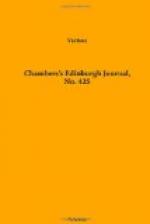the ancient doges. One, called the
Sala del
Maggior Consiglio, is 154 feet long by 74 broad.
It has a
dais at one end, on which the throne
must have been placed; and over this a picture of Paradise
by Tintoretto, covering the entire end of the room—of
course 74 feet long—being thus the largest
picture ever painted on canvas. Around, under
the ceiling, are the portraits of the series of doges.
The
Sala del Senato still exhibits the seats
of the senators, each furnished with its candlestick
for protracted discussions—a melancholy
memorial of departed independence. We gazed,
too, on the Hall of the Council of Ten, and the lesser
room where the more terrible Council of Three held
its sittings; all now reduced to mere show-places,
but still strongly suggesting their original destination.
The Lion’s Mouth, in the outer gallery, to which
any accusation could be committed, was not forgotten.
After dwelling a due time upon the rooms, and the numerous
pictures and other works of art presented in them,
we descended into the dungeons or
pozzi—narrow
stone-chambers destitute of light, where Venetian
justice formerly kept its victims—a terrific
specimen of the reckless inhumanity of past times.
Finally, we passed to the Bridge of Sighs, which is
detected to be an afterthought structure, designed
to connect the palace with the more modern prison in
the rear, a canal intervening. I suspect, after
all, that many of the stories told about the pozzi
and the bridge are mere myths, the reflection of ideas
which the appearance of the places suggests.
The church of San Marco, adjoining the palace, and
forming one side of the Piazza or square, is like
no other building I ever saw—decidedly
Oriental in style—indeed such a building
as Aladin might have evoked by his lamp; which reminds
me, by the way, that there is a prevalent tinge of
the East all over Venice, seen in the architecture
particularly. The vaulting and arching of this
church are all described as Byzantine in style, and
are therefore round; but it has been a custom in Venice
to fix up on such a building as this any reliques
of antique sculpture which have been taken in the countries
with which the Republic was at war: accordingly,
the front of San Marco bristles all over with curious
pillars and carvings, including, above all, the four
celebrated bronze horses which Napoleon took to Paris,
and which were restored after his downfall. Walking
through one of the low-browed doors, we pass across
a vestibule, where a stone is pointed out in the pavement
as the spot on which the emperor Barbarossa laid his
head beneath the foot of Pope Alexander III. Then
proceeding into the interior, you find the dusky atmosphere
dimly blazing with a peculiar glitter from the walls
and ceilings, the whole being one mass of gold mosaic,
on which scripture subjects are inserted in a darker
colouring. Think of a huge church, the interior
facing of which is composed of pieces of gilt stone,




